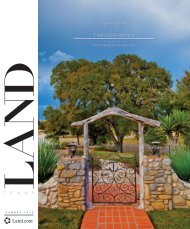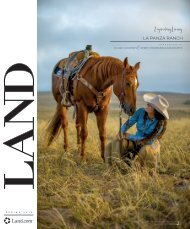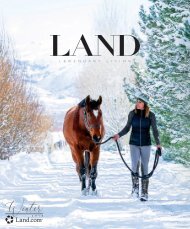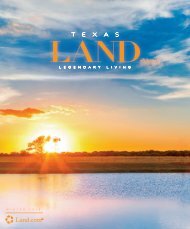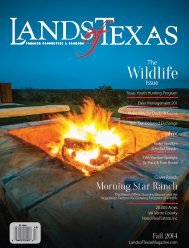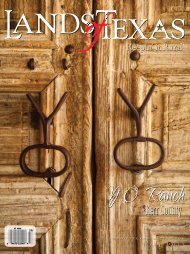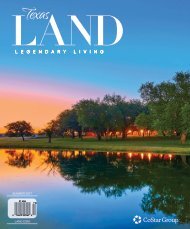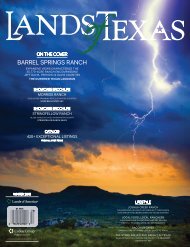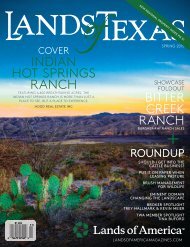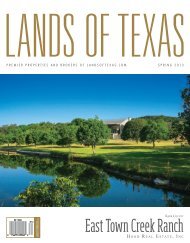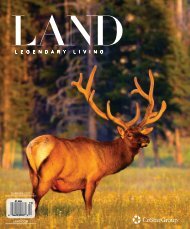You also want an ePaper? Increase the reach of your titles
YUMPU automatically turns print PDFs into web optimized ePapers that Google loves.
T he TWA Connection<br />
The <strong>Texas</strong> Wildlife Association understands<br />
that voluntary private land stewardship is the<br />
state’s most powerful force for conservation.<br />
These days, it takes diverse income streams<br />
ranging from livestock production and<br />
hunting to non-consumptive nature tourism<br />
activities like nature photography to keep<br />
land in private hands.<br />
Cathy Illg/Redcreek Ranch<br />
Tom Ulrich/Pierce Ranch<br />
A Case Study: Santa Clara Ranch (Starr County)<br />
The Santa Clara Ranch, located on 300 acres about 40 miles<br />
northwest of Edinburg, is John Martin’s favorite example of<br />
a successful nature photography destination.<br />
“In the mid-80s, the owner Dr. Beto Gutierrez, a native<br />
of Edinburg, <strong>Texas</strong>, made his way back to South <strong>Texas</strong><br />
after a stint in New Mexico where he was practicing<br />
medicine. When he came home, he bought 300 acres and<br />
immediately stocked it with cattle. Soon after the cattle<br />
market nose-dived.<br />
He told me, ‘I bought cattle—and I lost my ass.’<br />
I knew that while he was out-of-state, Dr. Gutierrez<br />
had acquired the skills to become a recreational nature<br />
photographer, so I suggested that he establish a nature<br />
photography destination. This was in 2008. He ran with the<br />
idea, but soon discovered that he didn’t have enough time<br />
to devote to operating a medical practice and developing<br />
a nature photo destination, so he brought in two fellow<br />
photographers to help.<br />
One, Hector Astorga, was a skilled amateur photographer<br />
with roots in Honduras. At the time, he owned another<br />
business, but as he began spending time on the ranch and<br />
discovering its hidden beauty and potential, he switched his<br />
focus. Soon, he was dedicating four to five days a week to<br />
developing and marketing the ranch.<br />
The first steps were identifying prime sites for photo<br />
blinds and optimizing them for photography success. For<br />
instance, the blinds are situated across from a pond and<br />
partially buried so the photographers are on eye-level with any<br />
animals or birds that come into the specially staged habitat.<br />
Hector’s initial marketing efforts consisted of joining<br />
photography forums and posting his stunning nature<br />
photos with both his name and Santa Clara Ranch. The<br />
photos caught the attention of his fellow photographers,<br />
who began inquiring about the chance to shoot at the Santa<br />
Clara. Hector began acting as a manager and a guide.<br />
Eighteen months into the business, they built a lodge—<br />
simple, clean and comfortable—so guests wouldn’t have to<br />
navigate the 40 miles back and forth to the nearest hotel.<br />
Over a period of three intensive years, they built it,<br />
marketed it, and photographers began to come. Eight years<br />
later, the Santa Clara is booked solid from March 1-July 1 with<br />
photographers. The operation nets about $60,000 year solely<br />
on photography and generates about $140,000 in economic<br />
impact in the nearby rural community. I venture to say very<br />
few 300-acre ranches generate that type of income.<br />
To top it off, Hector has gone from being an amateur with<br />
a passion for photography to a professional photographer,<br />
instructor and tour guide with a global reach. In addition to<br />
his workshops at the Santa Clara, he will be leading photo<br />
tours to Honduras and Africa in <strong>2017</strong>.”




